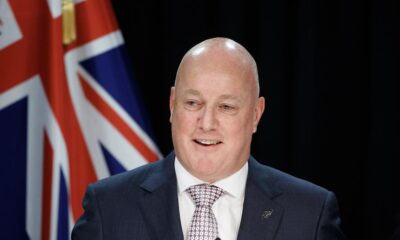Health
New Medical School at Waikato Promises Cost-Effective GP Training

A new medical school at the University of Waikato has been found to offer a better cost-benefit ratio than existing alternatives, according to a recently released business case. The analysis indicates that the school will incur lower operational costs and produce a higher percentage of graduates who will become general practitioners (GPs). Despite these findings, the University of Auckland has raised concerns regarding the assumptions made in the business case.
The New Zealand government has confirmed it will proceed with the Waikato medical school, with classes set to begin in March 2028. Health Minister Simeon Brown asserts that this new institution represents the most effective approach to enhancing the nation’s critical health workforce. The initiative aims to strengthen the rural GP workforce, which has faced challenges in recent years.
The business case, which included a comprehensive cost-benefit analysis conducted by Sapere, evaluated three potential options for expanding New Zealand’s medical training capacity. These options included increasing student intake at the existing University of Auckland and University of Otago, establishing a joint rural training program, and launching the new Waikato school. The findings revealed that the Waikato school would be the most economical option, with an estimated cost of $9.1 billion from 2026 to 2042. In contrast, increasing the intake at the existing schools would cost about $10.9 billion, while the joint training program would total around $10.27 billion.
Although the initial capital costs for the Waikato school are projected at $236.3 million, its operating costs of $361.6 million are significantly lower than the operational costs associated with the other options, which are estimated at $513.6 million for Auckland and Otago and $508 million for the joint program. The shorter duration of the Waikato course is a key factor contributing to these lower costs.
Despite these advantages, concerns have been raised about the fairness of the comparison presented in the business case. Professor Warwick Bagg, Dean of the University of Auckland’s medical school, noted that the analysis fails to account for the total educational costs associated with entering a graduate program. He pointed out that prospective students must first complete a prior degree, which typically takes at least three years and incurs government funding.
The Waikato school also boasts the highest cost-benefit ratio of the three options, estimated at 1.986. This means that for every dollar invested, the benefits are projected to be worth $1.99. In comparison, the Auckland and Otago option has a ratio of 1.495, while the joint rural training program has a ratio of 1.798. Furthermore, the Waikato program is anticipated to produce a significantly higher proportion of graduates who enter general practice, based on models from the University of Wollongong in Australia.
Nevertheless, Professor Bagg criticized the assumptions made in the business case, calling the modeling “experimental” and “speculative.” He emphasized that the Australian context differs considerably from New Zealand’s, particularly regarding incentives for rural general practice.
Minister Brown defended the analysis, stating that the figures were based on comprehensive data from existing Auckland and Otago graduates, as well as comparable programs in Australia. He described the decision to establish the Waikato Medical School as a “game-changer” for the future of New Zealand’s medical workforce.
The Waikato program aims to provide a post-graduate medical qualification similar to successful Australian models, incorporating a year-long primary care placement. This structure is designed to encourage graduates to work in primary care settings, thus addressing critical healthcare needs in communities.
Critics from the opposition, including Labour’s tertiary education spokesperson, Shanan Halbert, have argued that existing universities could produce more doctors efficiently if adequately funded. They stress the importance of ensuring that comparisons are made on a level playing field.
The Green Party’s tertiary education spokesperson, Francisco Hernandez, expressed skepticism about the government’s decision-making process. He criticized the timing of the document release and suggested that the analysis reflects an underlying bias against Auckland and Otago.
As New Zealand moves forward with the establishment of the Waikato Medical School, the implications for the country’s healthcare system and the training of future medical professionals remain a focal point of discussion among educators, policymakers, and health advocates.
-

 Sports2 months ago
Sports2 months agoNetball New Zealand Stands Down Dame Noeline Taurua for Series
-

 Entertainment2 months ago
Entertainment2 months agoTributes Pour In for Lachlan Rofe, Reality Star, Dead at 47
-

 Entertainment3 weeks ago
Entertainment3 weeks agoNew ‘Maverick’ Chaser Joins Beat the Chasers Season Finale
-

 Sports2 months ago
Sports2 months agoSilver Ferns Legend Laura Langman Criticizes Team’s Attitude
-

 Politics4 weeks ago
Politics4 weeks agoNetball NZ Calls for Respect Amid Dame Taurua’s Standoff
-

 Sports18 hours ago
Sports18 hours agoEli Katoa Rushed to Hospital After Sideline Incident During Match
-

 Entertainment2 months ago
Entertainment2 months agoKhloe Kardashian Embraces Innovative Stem Cell Therapy in Mexico
-

 World3 months ago
World3 months agoPolice Arrest Multiple Individuals During Funeral for Zain Taikato-Fox
-

 Sports3 months ago
Sports3 months agoGaël Monfils Set to Defend ASB Classic Title in January 2026
-

 Entertainment1 month ago
Entertainment1 month agoTyson Fury’s Daughter Venezuela Gets Engaged at Birthday Bash
-

 Sports1 month ago
Sports1 month agoHeather McMahan Steps Down as Ryder Cup Host After Controversy
-

 World2 weeks ago
World2 weeks agoSevere Winds Hit New Zealand, Over 100 Flights Canceled



















